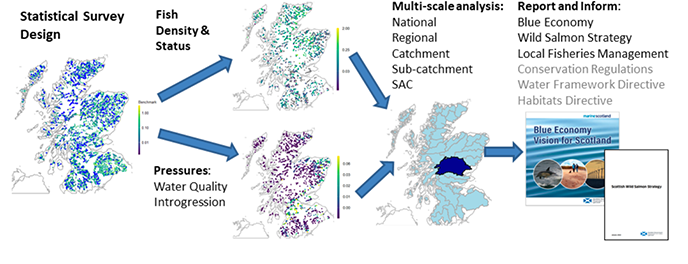National Electrofishing Programme for Scotland (NEPS) 2021: analysis
The National Electrofishing Programme for Scotland (NEPS) is a statistical survey design that ensures collection of unbiased data on the density and status of salmon and the pressures that affect them, including water quality and genetic introgression. This report presents the latest analysis.
Executive Summary
The National Electrofishing Programme for Scotland (NEPS) was established in 2018. The foundation of the programme is a statistical survey design that ensures collection of unbiased, spatially representative data on the abundance of freshwater fish and the pressures that affect them, including water quality and genetic introgression from farm escapes.
Survey design, data storage, analysis and reporting are provided by Marine Scotland. Data collection is undertaken by a network of professional local fisheries managers. NEPS data can be analysed at a range of spatial scales (national, regional, catchment, sub-catchment, site). The current assessment method provides a scientifically robust basis for assessing the status of salmon, identifying potential pressures, supporting local management decision making and policy imperatives (e.g. Blue Economy Vision for Scotland, Wild Salmon Strategy). With further work, similar assessment approaches could support a range of reporting requirements including Habitats Directive, Water Framework Directive and Conservation Regulations, depending on available resource. NEPS provides the evidence base necessary to plan conservation, restoration and management of Atlantic salmon and with further development, other freshwater fish species including brown trout and European eel. The latest data show that densities of salmon fry (0+) in 2021 were lower than 2018, but higher than 2019 and were overall healthy at a national scale. In contrast salmon parr (≥1+) densities were extremely low at around 60% of their target level. However, there was also substantial regional variability. In the case of salmon parr, healthy (Grade 1) populations were only found in the north. Comparison of mean juvenile densities from NEPS with regional rod catch data indicated broadly coherent spatial and temporal relationships. This consistency between abundance indicators used in different assessment methods is reassuring when making management decisions.
Water quality data highlighted potential pressures from nutrient pollution, particularly in the north-east, central belt and Ayrshire coast, while anthropogenic acidification impacts appear to remain a localised problem in the south-west of Scotland. High nutrient loads and eutrophication impacts are likely to become an increasing problem under climate change when combined with low summer flows and high temperatures.

Contact
Email: neps@gov.scot
There is a problem
Thanks for your feedback